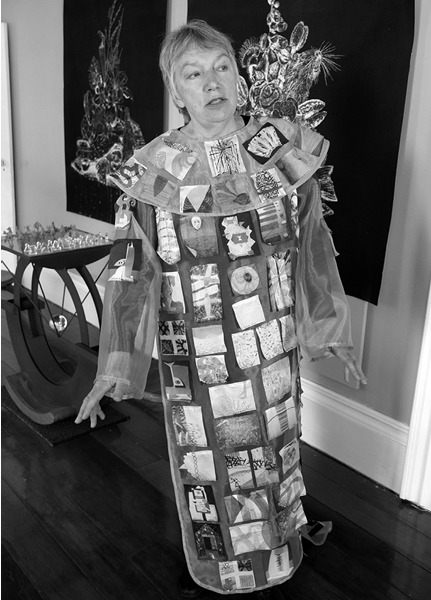
PRACTICE FOR THE AFTERLIFE
first performed on October 12, 2018
Art Kettle, Manchester, MI
performed 24 times in 2018
MARGARET PARKER
Ann Arbor, MI
977987540m977987540p977987540a977987540r977987540k977987540e977987540r977987540s977987540t977987540@977987540g977987540m977987540a977987540i977987540l977987540.977987540c977987540o977987540m
margaretparkerstudio.com
PRACTICE FOR THE AFTERLIFE
MARGARET PARKER
“Practice for the Afterlife” combines performance art with internal monologue to integrate all eleven rooms of the exhibition sight in an exploration of the interior life of a woman artist at 71. The costume I made for the piece was a celebration of a full artistic life—a walking retrospective—with examples from 50 years of my work printed on silk and sewn onto a translucent organza gown. As I wander through the rooms of the house, I speak of the internal dreams, reckonings, inventories, and furies that surround me, and the creative process that goes on throughout a lifetime.
The setting of the piece is intrinsic to the work. It was performed in an 1836 brick house with eleven rooms and hallways, the first house built in Manchester, Michigan, which has recently been renovated into a community art center called the Art Kettle. Its first exhibition, “Dear Womanhouse, What Now?” for which the piece was made, was developed as an homage to the original “Womanhouse” project by Judy Chicago and Miriam Shapiro and their students in 1972. We saw it as a challenge to show how a new group of women and non-binary artists would see themselves and their work today.
The 26 artists involved each chose a room whose purpose fit their work. What they made was often direct and challenging in its feminist intent, taking on social media, immigration’s cultural erasures, racial identity, sexual abuse and trafficking, memory and loss, and gender transitioning. These works made a stunning collaboration with my roving character.
Speaking my own poetry as I moved through the house, I didn’t make eye contact with viewers because I wanted them to experience what goes through the mind of an artist when she’s all alone. The poem had seven sections, each part was completed in a room before I moved on. Each section was an improvisation with the viewers present in the moment, each room provided a different experience. To hear the whole piece a viewer would need to follow me through the whole house. In this way, the performance worked in the vein of performance art, a live event that a viewer can enter or leave at any time.